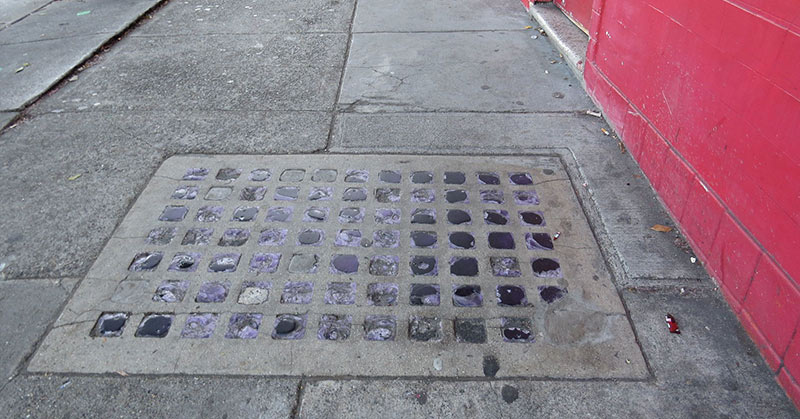If you take a stroll down the streets of a number of major cities around the world, you are likely to notice a peculiar feature in the sidewalks: small, sometimes purple, glass squares and circles in grid patterns covering a few feet of pavement.
While these installations do look pretty, they also serve a purpose. Known as vault lights, sidewalk prisms, or pavement lights, these bits of glass that are flush with the sidewalk are there to allow sunlight into the spaces below [1].
The Invention of Vault Lights
The first vault light was patented by Edward Rockwell in 1834, which featured a round iron plate surrounded by a large glass lens. Several years later, in 1845, Thaddeus Hyatt patented his own improved design, which was more resistant to fracturing. His are the lights that we still see today [2].
Initially, vault lights were used on ship decks to provide light below without the need for hazardous open-flame lights, like kerosene lamps. They were later used in city sidewalks to allow light to pass into spaces below. Before the availability of electricity, rooms under sidewalks and other overhead structures were too dark to be of any use. The installations of vault lights made them usable for storage, and even for apartments in some cases [3].
Although they appear smooth and flat on the top, these little pieces of glass actually have a prism shape underneath, which diffuses the light and spreads it through a larger area. Multiple prisms set at different angles have the capability to fill an entire room with light.
Read: Architect Turns Old Cement Factory Into His Home, And The Interior Will Take Your Breath Away
A Sustainable Solution
Electricity was not yet available in the mid-nineteenth century, so buildings had to be lit using fuels like oils, gas, and candles. These items all cost money, so vault lights provided a way to preserve these fuels and energy in spaces that could not admit natural lighting [3].
Additionally, lamps, candles, and other lighting devices could often produce smoke, reducing the air quality in enclosed spaces. Having natural light from above meant you needed fewer of these smoke-producing items down below [3].
Vault Lights Today
Vault lights can still be seen in many cities today, and city leaders and historic preservation groups have recognized both the historical significance, as well as the aesthetic appeal, that these lights provide. As such, there has been an effort in many cases to restore and preserve these patches of sidewalk [3].
In Sacramento, California, visitors have the unique opportunity to walk underneath the sidewalk past abandoned storefronts, guided by the light of vault lights. This is because in 1862, parts of the city were raised as much as fourteen feet to protect from flooding. In some buildings, they simply built over the first floor, rather than lifting the entire structure, which provided this interesting underground walkway through time [1].
Read: The World’s Largest Privately Owned Sequoia Forest Is Now Officially Protected
Why is the Glass Colored?
The purple color that you see in most vault lights today is actually an indication of age. This is because the lights are made of glass, which is made of silica. Silica is found in sand, which also contains other elements.
Chemists used manganese dioxide to clarify and stabilize the glass from these other elements, which oxidizes and turns purple or pink when exposed to the UV rays from the sun over a long period of time [1].
This process can take several years, so when you see it, that means it is either quite old, or it has been dyed that way in a restoration project.
Unfortunately, many of these vault light systems have deteriorated over the decades, and have created hazards with broken seals and broken glass. This could also allow water to penetrate the surface and damage the area below, so many of them have been covered, removed, or filled with concrete [3].
There are, however, still some of these pretty sidewalk installments here and there, and while they are less necessary in today’s modern world, they are a lovely reminder of the ingenuity of the past.

